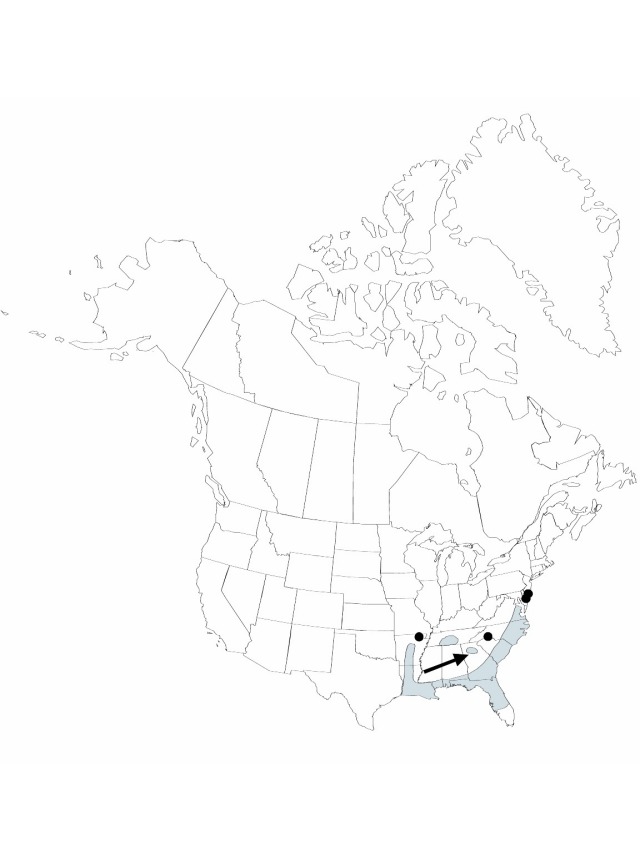Difference between revisions of "Juncus elliottii"
Fl. South. U.S. 494. 1860.
FNA>Volume Importer |
imported>Volume Importer |
||
| (6 intermediate revisions by 2 users not shown) | |||
| Line 6: | Line 6: | ||
|place=494. 1860 | |place=494. 1860 | ||
|year=1860 | |year=1860 | ||
| + | }} | ||
| + | |special_status={{Treatment/ID/Special_status | ||
| + | |code=E | ||
| + | |label=Endemic | ||
}} | }} | ||
|basionyms= | |basionyms= | ||
| Line 23: | Line 27: | ||
|elevation=0–700 m | |elevation=0–700 m | ||
|distribution=Ala.;Ark.;Del.;Fla.;Ga.;La.;Miss.;N.J.;N.C.;S.C.;Tenn.;Tex.;Va. | |distribution=Ala.;Ark.;Del.;Fla.;Ga.;La.;Miss.;N.J.;N.C.;S.C.;Tenn.;Tex.;Va. | ||
| − | |discussion=<p>Juncus elliottii has tubers at the ends of the roots.</p> | + | |discussion=<p><i>Juncus elliottii</i> has tubers at the ends of the roots.</p> |
|tables= | |tables= | ||
|references= | |references= | ||
| Line 32: | Line 36: | ||
-->{{#Taxon: | -->{{#Taxon: | ||
name=Juncus elliottii | name=Juncus elliottii | ||
| − | |||
|authority=Chapman | |authority=Chapman | ||
|rank=species | |rank=species | ||
| Line 46: | Line 49: | ||
|publication title=Fl. South. U.S. | |publication title=Fl. South. U.S. | ||
|publication year=1860 | |publication year=1860 | ||
| − | |special status= | + | |special status=Endemic |
| − | |source xml=https:// | + | |source xml=https://bitbucket.org/aafc-mbb/fna-data-curation/src/2e0870ddd59836b60bcf96646a41e87ea5a5943a/coarse_grained_fna_xml/V22/V22_214.xml |
|genus=Juncus | |genus=Juncus | ||
|subgenus=Juncus subg. Septati | |subgenus=Juncus subg. Septati | ||
Latest revision as of 20:30, 5 November 2020
Herbs, perennial, cespitose, 3–9 dm. Roots often with terminal tubers. Culms erect, terete, 1–3 mm diam., smooth. Cataphylls 1, maroon to brown, apex acute. Leaves: basal 1–3, cauline 1–2; auricles 0.5–2 mm, apex rounded, scarious; blade green or maroon, compressed, 2–16 cm × 1–2 mm. , with faint ringlike bands at position of septa. Inflorescences terminal panicles of 40–100(–200) heads, 4–16 cm, branches ascending to spreading; primary bract erect to ascending; heads 2–10-flowered, hemispheric to obpyramidal, 0.3–0.5 mm diam. Flowers: tepals straw-colored, lanceolate, apex acuminate; outer tepals (2.2–)2.6–2.9 mm; inner tepals (1.8–)2.4–2.8; stamens 3, anthers 2/3 to equal filament length. Capsules exserted, chestnut brown, 1-locular, narrowly obpyriform to narrowly ovoid, 2.4–2.9 mm, apex acute, valves separating at dehiscence. Seeds ellipsoid, 0.3–0.5 mm, not tailed; body clearly yellow-brown. 2n = 40.
Phenology: Fruiting summer.
Habitat: Wet sands, peaty sands, or peat, exposed shores of ponds and lakes, depressions in savannas and flatwoods, moist to wet, much disturbed clearings, roadsides and ditches
Elevation: 0–700 m
Distribution

Ala., Ark., Del., Fla., Ga., La., Miss., N.J., N.C., S.C., Tenn., Tex., Va.
Discussion
Juncus elliottii has tubers at the ends of the roots.
Selected References
None.